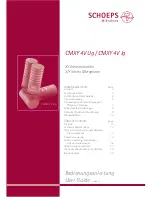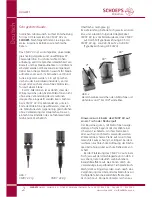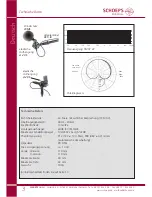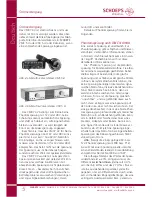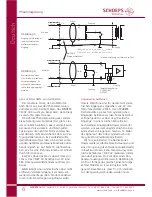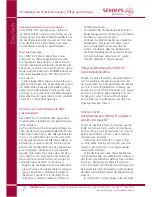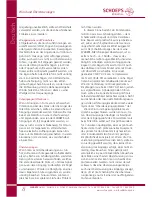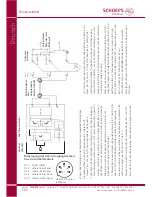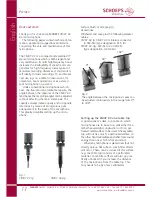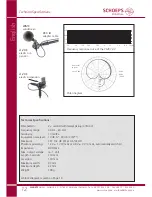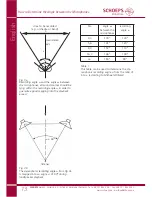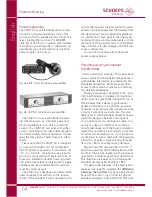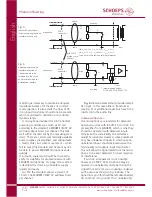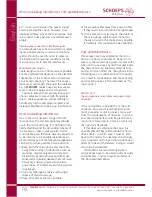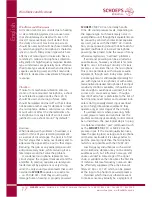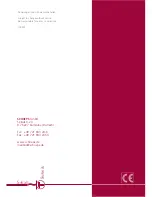
matching is necessary to maintain adequate
impedance balance for the sake of common
mode rejection. It also avoids the flow of DC
in an input transformer should one be present,
which could lead to distortion or a reduced
dynamic range.
A microphone designed for 48 V phantom
powering could draw as much as 10 mA
according to the standard; a
SCHOEPS
CMXY 4V
will draw about 4 mA per channel. This falls
well within the limit set by the prevailing stan-
dard. There are certain commercially available
power supplies, preamplifiers, and mixing desks
– mostly older, but some more recent – which
fail to meet this standard and hence may not
be able to power
SCHOEPS
microphones ade-
quately.
If in doubt, equipment should be checked to
verify its suitability for professional work with
SCHOEPS
microphones. On page 10 a method
is described for checking a phantom supply
quickly and easily.
For P12 the standard allows a current of
15 mA. The
SCHOEPS
CMXY 4V will draw 8 mA
per channel.
Fig. 6
shows a bal an ced but groun ded am pli-
fier in put. In this case eit her a trans for mer
(see Fig. 5) or ad di tio nal ca pa ci tors ha ve to be
in ser ted into the au dio li ne.
Unbalanced Operation
Our microphones are intended for balanced
operation such as with the VMS 5 U or VSR 5 U
preamplifier from
SCHOEPS
, which is why they
should be operated with balanced inputs.
Otherwise the vulnerability to interference
would be increased. However some equipment
only has unbalanced inputs in which case an
unbalanced input should be balanced with a
high-quality microphone input transformer.
This will allow the signal leads from the micro-
phone to be kept balanced, for best rejection
of interference.
If such an arrangement is not possible,
however, a CMXY 4V microphone may be
operated in unbalanced mode by taking the
signal from pin 2 (4) via a coupling condenser
with a value as shown in Fig. 6 above. The
signal from pin 3 (5) should be left unconnected;
do not short it to ground. This ”unbalancing
SCHOEPS
GmbH · Spitalstr. 20 · D-76227 Karlsruhe (Durlach) · Tel: +49 721 943 20-0 · Fax: +49 721 943 2050
www.schoeps.de · [email protected]
Phantom Powering
15
English
+ phase
- phase
2 (4)
3 (5)
microphone
1
screen
cable
powering
R
S
U
S
input
R
S
P48: U
S
=
48 V ± 4 V; R
S
= 6,8 k
W
*,
I
max.
= 10 mA
P12: U
S
=
12V ± 1V; R
S
= 680
W
*,
I
max.
= 15 mA
I
/2
I
/2
I
+ phase
- phase
2 (4)
3 (5)
microphone
1
screen
cable
powering
R
S
U
S
input
R
S
R
R
C
C
*
see note in the text concerning tolerances
Fig. 6
balanced, ungrounded,
transformerless input.
Condensers must be
inserted into the circuit
and provision made for
polarization resistors.
Fig. 5
input with transformer
(or balanced, ungrounded
transformerless input)
XLR-3
connector
XLR-3
connector
*
recommended values:
C: 100
μ
F, 63V; R: 22k
Ω
, 1%
shield
shield
with XLR-5
(stereo micro-
phones)
*
*
*
*

